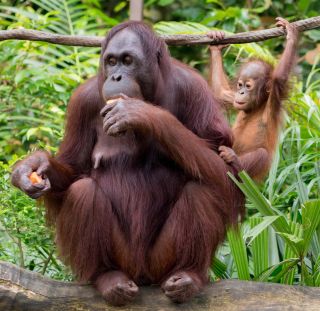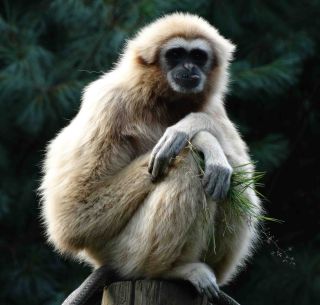Laughter
When Apes Laugh, They Offer a Window Into Human Evolution
Do You “Oouchy-gouchy-goo-zoooom”?
Posted June 30, 2023 Reviewed by Tyler Woods
Key points
- Like their close kin, the chimpanzee, gorillas and orangutans express laughter during playful interactions.
- All the great apes use a breathy, chuckling, panting laughter during rough-and-tumble play and play chases.
- They are especially fond of tickling exchanges, even anticipating an “oouchy-gouchy-goo-zoooom” tickle.
In the quest to fully grasp both the meaning and purpose of laughter, some experts have come to realize the importance of understanding its evolutionary origins. Did our distant ancestors use it as a communicative signal and, if so, in what contexts?
Thus far, I’ve related accounts about how all our great ape relatives—chimpanzees, gorillas, and orangutans—use laughter-like vocalizations during play exchanges in much the same way humans do. In an earlier post, I also provided YouTube links with examples of a common chimpanzee (Pan troglodytes) and a bonobo (Pan paniscus) engaged in laughter.
Here I’ll provide similar accounts for gorillas (genus Gorilla) and orangutans (Pongo pygmaeus). Collectively, they suggest laughter’s evolutionary origin extends back at least to the great ape common ancestor, which roamed the earth some 14 to 18 million years ago (Tattersall, 1998).

Laughter in the Gorilla
All four gorilla subspecies have a vocal repertoire that includes “pig grunts,” “lip-smacking,” and the characteristic “hootseries,” the loud vocalizations of mature silverback males that often precede their chest-beating displays (Fossey, 1983). By and large, however, gorillas are less communicative than chimpanzees, spending more time eating and less time in vocal exchanges with group members.
In her book, Gorillas in the Mist, Dian Fossey noted two encounters that involved the mountain gorilla equivalent of laughter.
"Once, from a hidden position, I watched Digit, about five and a half years old, tumble onto (the silverback) Uncle Bert’s lap much like a puppy wanting attention. From a lazy sunning position, Uncle Bert had watched the youngster’s approach, then quickly plucked a handful of white everlasting flowers (Helichrysum) to whisk back and forth against Digit’s face, as if trying to tickle the young male. The action evoked loud play chuckles and a big toothy grin from Digit, who rolled against Uncle Bert’s body, clutching himself ecstatically before scampering off to playmates more his own size."
The author also had occasion to interact with two young, orphaned gorillas that were dependent on humans for care.
During these relaxed sessions I learned a great deal about gorilla behavior that I had not gained previously from free-ranging animals who had yet to become totally habituated to my presence. Tickling between Coco and Pucker provoked many loud play chuckles and also lengthened their play sessions. Tentatively, I first tried out tickling on Coco, and after receiving a very receptive response tried it later with Pucker. After a few weeks I changed approaches from mild “tickle-tickles” to drawn-out “oouchy-gouchy-goo-zoooom” tickles, much like those given by parents or grandparents when zeroing in with a teasing finger for a child’s belly button. The term “oouchy-gouchy-goo-zoooom” is not in any dictionary, yet it seems to be an international and interspecific term that can provoke laughter and smiles from both humans and nonhuman primates. Later, I had occasion to tickle free-living gorilla youngsters in the same manner and was able to elicit the same delighted responses.
In this short video, we can hear a young, orphaned gorilla’s laughter as it is tickled by a human foster parent.
As is the case with chimpanzees, orphaned gorillas involved in language studies exhibit a strong desire to engage in play wrestling and tickle sessions. The female lowland gorilla, Koko, who was trained by Francine Patterson in the use of American Sign Language, actually invented her own word for tickle (Patterson and Linden, 1981; Miles and Harper, 1994). In this video, it is obvious that Koko loved participating in both sides of playful physical exchanges with her human caretakers, adopting a play-face (mouth open, upper lip relaxed, lower lip exposing the lower teeth) to reassure her mentor and friend.

Laughter in the Orangutan
Orangutans occupy the tropical forest canopies of Sumatra and Borneo. Their auditory communications include the lip-smack and kiss-squeak. For females, there is also a “woo-woo” vocalization. The low growl, “gloomy” bellow, and the one- to four-minute “long-call” are exclusively performed by males, which, other than mating encounters, are mostly solitary creatures.
Close-up observations of wild orangutans are extremely difficult to obtain, and there is little evidence of playful interactions when adult females and their young do cross paths. Still, there have been references by several observers, including Charles Darwin, to a “chuckling” laughter-like vocalization used by captive orangutans. Referring first to chimpanzees and gorillas, he notes that “young orangs, when tickled, likewise grin and make a chuckling sound...” (quoted in Fry, 1977).
William Fry adds:
"I, myself, have heard this ‘chuckling or laughing sound’ produced by all these three primate species mentioned [chimps, gorillas, and orangs] and can state that the behaviour is similar in all three, and its basic characteristics are similar to those of a common form of human laughter.”
Today, within artificial groupings of orphaned young, play-fighting is commonplace. A photo in Anne Russon’s book, Orangutans: Wizards of the Rain Forest, shows two juveniles engaging in a “hearty” wrestling match, and one of the pair appears to be in the throws of laughter. In this YouTube video, a young captive orang, though we cannot hear it, certainly appears to be rather amused by a bit of sleight-of-hand.

The Gibbons
For the so-called “lesser apes”, observations in captivity may be the most conclusive, as they rarely leave the highest branches of the most mature Southeast Asian rain forests. Some years ago, a curator of mammals at the Honolulu Zoo with over 25 years of experience caring for two gibbon species revealed they don’t appear to emit anything comparable to laughter. Even juveniles with unnaturally easy access to social-play situations engage each other in virtual silence.
Thus, as best as we can tell, among primates at least, laughter-like vocalizations are limited to the great apes, making laughter roughly 16 million years old and highly correlated with playful interactions. Why this connection is so strong will be the subject of a future article.
This post was drawn from Chapter Seven of Why We Laugh: A New Understanding.
© John Charles Simon
References
Fossey, D. (1983). Gorillas in the Mist. Boston: Houghton Mifflin.
Galdikas, B. M. F. (1995). Reflections of Eden: My Years with the Orangutans of Borneo. Boston: Little, Brown and Co.
Miles, H. L. W. and S. E. Harper. (1994). “Ape Language” Studies and the Study of Human Language Origins. In D. Quiatt and J. Itani (Eds.), Hominid Culture in Primate Perspective. University Press of Colorado.
Patterson, F. and E. Linden. (1981). The Education of Koko. New York: Holt, Rinehart and Winston.
Russon, A. E. (2000). Orangutans: Wizards of the Rain Forest. Buffalo, NY: Firefly Books Ltd.
Simon, J. C. (2008). Why We Laugh: A New Understanding. Starbrook Publishing.
Tattersall, I. (1998). Becoming Human: Evolution and Human Uniqueness. Orlando, FL: Harcourt Brace and Co.




